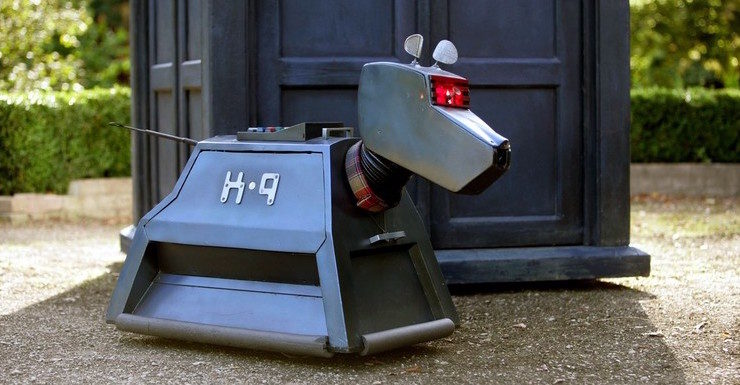For as long as humans have built machines, we’ve sought to emulate animals with machinery. Clockwork animals have long been playthings of royalty. Replacing animal power with steam power was one of the catalysts of the Industrial Revolution, and we still measure an engine’s might by horsepower. In our new anthology, Mechanical Animals, we asked some of our favorite authors of fantasy, horror, science fiction, and weird fiction to conjure their own unique and startling visions of the mechanized animal, be it in the distant, imagined past or some biomechanical future. But there are many real-life examples and archetypes of this trope throughout history that helped inspire us—and here are five we’ve particularly pondered.
The Elephant
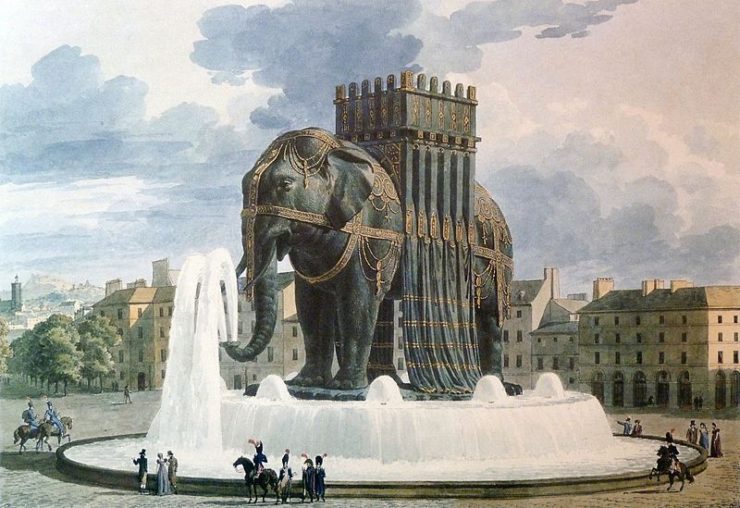
You can’t discuss mechanical animals without first summoning Jules Verne, who crafted some of fiction’s most memorable machinations, including the cetacean-inspired submersible, the Nautilus (see below), and the eponymous The Steam House.
This Belle époque RV caravan features two carriages drawn by a 20 foot, steel-clad, steam-powered mechanical elephant. With its howdah as cockpit, it wheels 12 travelers cross-country through India. It’s an excellent mimic, from its trumpeting trunk acting as the steam-release valve to the texture and color of its skin. It’s so uncanny that onlookers are baffled by its organic appearance juxtaposed with its apparent machinations.
Although characters were disconcerted, its appearance would have felt familiar to French readers. Verne was most likely inspired by a plaster maquette elephant that stood in the Place de Bastille from 1813 through 1846. One of Napoleon’s failed projects, this prototype was suppose to be a 78 foot tall bronze behemoth representing France’s colonial prowess via its ornamental howdah which visitors could ascend. Napoleon desired to be seen in the tradition of the great Greek and Roman emperors, who appropriated pachyderm symbology and utility from the Persian empire. But like his heroes, Napoleon’s empire soon fell, and the rough draft Elephant of the Bastille was left to the rats until demolished in 1846.
While the Steam House’s design and utility can be found directly in French culture, it also references one of the first functional automata, a water clock, invented by Muslim polymath Al-Jazari around 1206 AD. The Elephant Clock was 22 feet tall, and utilized water tanks, strings, and weight to animate all of the animals, a dragon, snake, phoenix, and human. These figures all represent different countries—the elephant symbolizes India and Africa—and celebrates Al-Jazari’s multicultural time. To read more about the Elephant Clock, or Al-Jazari’s myriad other mechanical inventions, track down The Book of Knowledge of Ingenious Mechanical Devices. —SC
The Duck
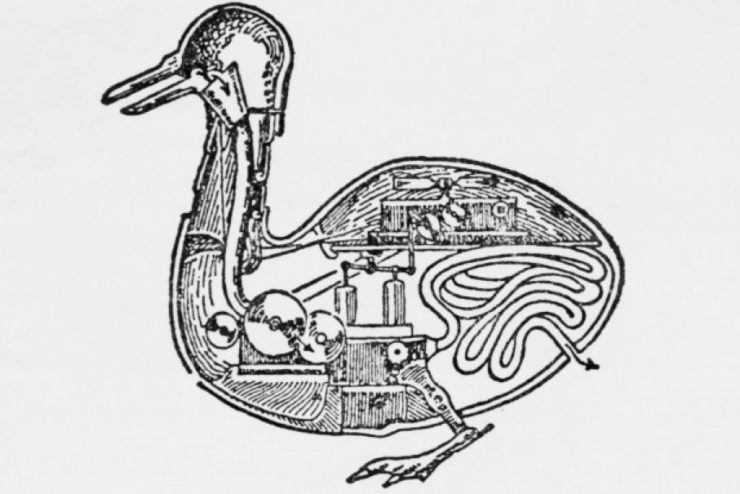
French inventor Jacques du Vaucanson’s automata were mostly humanoid. “The Flute Player” and “The Tambourine Player” were elegant and lifelike objects designed to entertain onlookers at Paris’ Académie des Sciences. However, it was his Digesting Duck that captured the world’s imagination for eons to come in 1739.
Was it because it was kind of a waddling fart joke? Maybe. It does seem almost absurd that this life-sized golden bird was designed only to eat and digest grain solely for pooping before an awed audience. Even so, the Digesting Duck’s mechanism was a bit misleading—the fed food collected inside one compartment, while ready-made “feces” dropped from a second. The complex digestion mechanism many were convinced Vaucanson invented for the Duck proved to be only legerdemain.
The trick’s simplicity aside, by pooping, the duck performed nature’s basest transmutation; or, as professor Jean-Claude Simard writes: “the concept of programming … i.e., giving the machine instructions to perform a predetermined action.”
Perhaps this is why the Duck constantly reappears within literature. Thomas Pynchon’s Mason & Dixon features a second prototype—female, conscious, and programmed for “erotic apparatus,” the joke being that the most natural and base imitation of life after shitting is fucking. She fails to find a compatible mate, and settles for stalking a famous chef from Paris to the US. The Digesting Duck also appears in Lavie Tidhar’s The Bookman, but as a forgotten leaping point to towards more authentic simulacrum. —SC
The Whale
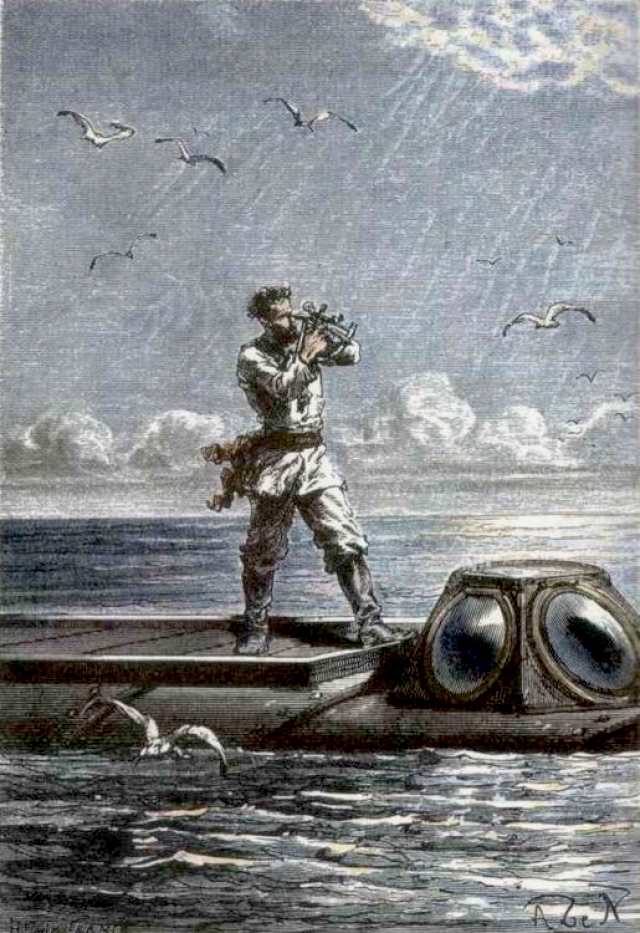
When it comes to mechanical whales, it’s quality over quantity. Yes, Googling the keywords will lead to a vast gallery of contemporary sculptures and paintings imagining the leviathan as some kind of automata-like vessel, but these are all variations on the same theme invented by Jules Verne. In 20,000 Leagues Under the Sea, the Nautilus, a submarine of ambiguous whale-attributes, is almost the more memorable character than its Captain.
What is most interesting about the Nautilus, though, isn’t its mechanizations, but its implicit illustration of technological and cultural cross-pollination. Verne was very influenced by U.S. writers and inventors. There’s Melville’s Moby Dick, but also Edgar Allan Poe’s The Narrative of Arthur Gordon Pym, which preceded the white whale by 12 years. Also a fan of inventor Robert Fulton, Verne named Nemo’s craft after his first functional submersible, Nautilus, built and exhibited in Paris in 1800.
As in The Steam House, Verne looks to nature to guide man-made function. The Nautilus is designed to deep dive like cetacea, and has a buoyancy system that spouts water when it surfaces. To unaware onlookers, they think they are seeing a whale and not an iron-clad submarine emptying its flood tanks. It also features a ramming prow that could decimate a ship, possibly inspired by not only the narwhal, but by accounts of U.S.S. H. L. Hunley’s terrorizing Civil War feats.
The Nautilus is a pretty hard icon to beat, and there have been countless re-imaginings. None, however, have been as captivating and enigmatic as Scott Westerfeld’s Leviathan series. Here, he expounds upon the idea of the whale as an ideal war machine by transforming it into an airship. —SC
The Insect

With their exquisite and sometimes geometrical biological construction, insects have long been a fertile subject of mechanical speculation. The materials of which they consist seem fabricated, from the hard, smooth shells of beetles to the delicate lacework of a dragonfly’s wings to the compound eyes of the common housefly.
One of the most philosophical visions of a mechanical insect in the American literary canon comes via Nathan Hawthorne. In his 1844 short story “The Artist of the Beautiful,” the famed author of The Scarlet Letter told the fantastic tale of a machinist who—a year before Thoreau retreated to Walden in real life—communes with nature and resolves the dichotomy of industrial and rural life in the 19th century by devising a mechanical butterfly. In doing so, Hawthorne crafted one of the earliest works of modern science fiction.
The image of the clockwork insect has endured. Today, the artist Mike Libby focuses on sculpting such creatures; his body of work, which he has dubbed Insect Lab, features the preserved bodies of insects, which he painstakingly modifies with pieces of machinery. The result is an eerie—and eerily simpatico—symbiosis between chitin and steel, between arthropod and architecture. —JH
The Dog
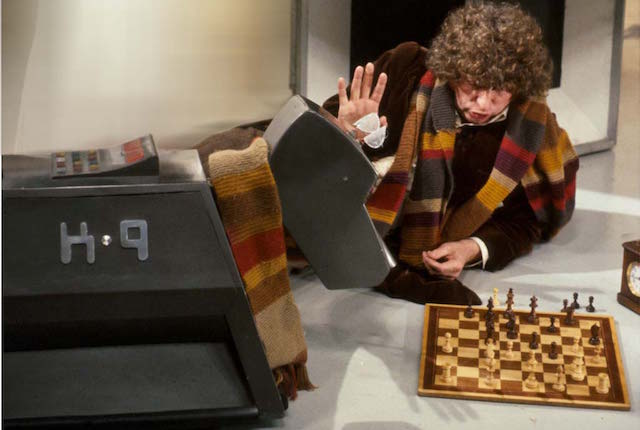
It’s only natural that man’s best friend has so often been given the mechanical treatment. Few animals have lived as closely with humans throughout history, and that domestication has bred a familiarity and empathy that can make for some of the most accessible mechanical animals in culture—particularly pop culture.
On television, an entire generation of science fiction fans fell in love with the idea of mechanical dogs, including the iconically boxy and faithful companion K-9 from Doctor Who to Muffit, the fur-meets-metal pup from the original Battlestar Galactica series—the latter character portrayed, oddly enough, by a chimpanzee in a robot-dog costume. On the big screen, feature films such as C.H.O.M.P.S. from 1979 and A-X-L from this year have explored, with varying degrees of success, what makes the whole concept of a canine built of plastic and steel so compelling.
In the real world, Sony has even taken the step of rebooting its lapsed line of robot dogs. Aibo was introduced this year, and the terrier-sized mecha-pooch is being pushed as a cheaper (in the long run) and more convenient way of having a tail-wagging pet waiting for you when you come home. Regardless of what the future may hold for mechanical animals in our everyday lives, it’s clear that the allure of these beings of artificial nature isn’t going away soon. —JH
 Selena Chambers (@BasBleuZombie) and Jason Heller (@jason_m_heller) are the editors of Mechanical Animals: Tales at the Crux of Creatures and Tech, a speculative fiction safari that riffs on the traditional ideals of automata to explore our strange and competitive relationship with the natural world. Available November 27 from Hex Publishing, it features two introductions by Insect Lab’s Mike Libby, and SFF scholar and author Jess Nevins, alongside 21 stories from authors such as Jules Verne, Carrie Vaughn, Molly Tanzer, Ailette de Boddard, Kat Howard, Nick Mamatas, Nathaniel Hawthorne, Lauren Beukes, Maurice Broaddus and Sarah Hans, Jesse Bullington, Stephen Graham Jones, Joe Pulver, Michael Cisco. You can catch a copy in the wild at Amazon or Hex Publishing.
Selena Chambers (@BasBleuZombie) and Jason Heller (@jason_m_heller) are the editors of Mechanical Animals: Tales at the Crux of Creatures and Tech, a speculative fiction safari that riffs on the traditional ideals of automata to explore our strange and competitive relationship with the natural world. Available November 27 from Hex Publishing, it features two introductions by Insect Lab’s Mike Libby, and SFF scholar and author Jess Nevins, alongside 21 stories from authors such as Jules Verne, Carrie Vaughn, Molly Tanzer, Ailette de Boddard, Kat Howard, Nick Mamatas, Nathaniel Hawthorne, Lauren Beukes, Maurice Broaddus and Sarah Hans, Jesse Bullington, Stephen Graham Jones, Joe Pulver, Michael Cisco. You can catch a copy in the wild at Amazon or Hex Publishing.










